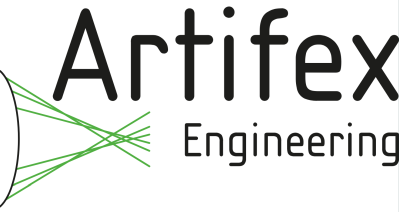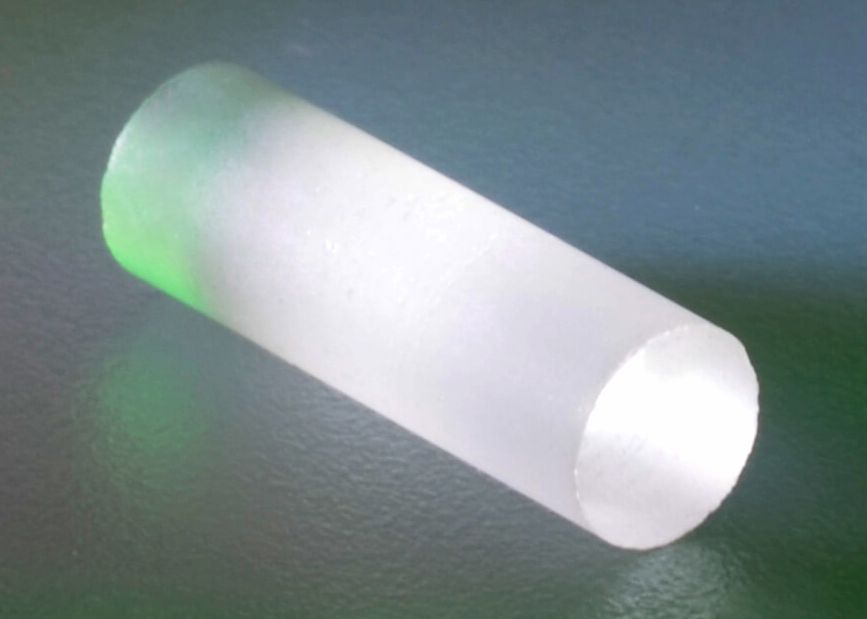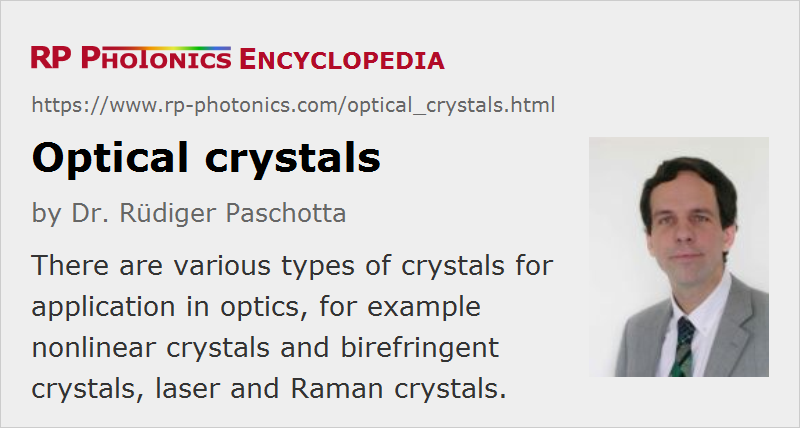Optical Crystals
Definition: crystals for optical applications, usually single crystals, often with polished end faces
More general term: optical materials
More specific terms: nonlinear optical crystals, birefringent crystals
German: optische Kristalle
How to cite the article; suggest additional literature
Author: Dr. Rüdiger Paschotta
A wide range of optical materials is used in different fields of optics. As transparent materials, one often uses optical glasses, but for various applications one requires optical crystal materials – mostly monocrystalline materials – because of their special properties:
- In contrast to glasses, crystals can exhibit birefringence, as required for various types of polarizers, waveplates, birefringent tuners and other optical components. Often used birefringent crystal materials are quartz, calcite and sapphire.
- Crystal materials with not too high symmetry of their crystal lattice (e.g. trigonal, tetragonal or monoclinic) can exhibit a χ(2) nonlinearity. This is used mostly for nonlinear frequency conversion, but also for optical modulators (e.g.Pockels cells).
- Although materials for acousto-optic modulators do not generally need to be crystalline, acousto-optic crystals are used in some cases, e.g. for acousto-optic tunable filters where birefringence is essential.
- Other crystals are used as Raman crystals. Here, one exploits stimulated Raman scattering, mostly for purposes of nonlinear frequency conversion.
- A wide range of crystal materials can be used as laser crystals, i.e., as host materials for laser-active dopants – either rare earth ions or transition metal ions. Compared with laser-active glasses, they typically exhibit relatively high transition cross sections, a small gain bandwidth and good heat conduction. Often, they also allow for higher doping concentrations. Birefringence is also useful in some cases, e.g. for avoiding depolarization losses.
- In some cases, crystal materials are used in spectral regions where glasses do not have sufficiently wide wavelength ranges with high transmissivity. In particular, various materials such as zinc sulfide, zinc selenide and sapphire are used as infrared crystals, and other materials such as lithium fluoride, calcium fluoride and magnesium fluoride are used as ultraviolet crystals.
- The typically much higher thermal conductivity of crystal materials is also relevant for some applications, e.g. for minimizing thermal lensing effects. In some cases, heat conduction is even the primary purpose of an optical crystal; for example, there are diamond heat spreaders.
- The Faraday effect (magnetic field induced polarization rotation) in some crystal materials (e.g. terbium–gallium garnet) is used for Faraday rotators and Faraday isolators.
- The pyroelectric effect in some crystal materials is exploited in pyroelectric detectors.
- Certain materials can be used scintillator crystals for detecting radiation.
Most optical crystals are insulating materials, having a wide band gap and very low absorption in the visible spectral region. However, there are also semiconductors used as optical crystals, e.g. as infrared crystals, where intense absorption in the visible region is not relevant.
Optical crystals are made with a wide range of geometric shapes, including simple cuboids, but also cylinders and other shapes with curved surfaces. A special form of crystals are single-crystal fibers, often having an extreme radio of length to diameter.
Various Aspects of Optical Crystals
Fabrication; Crystal Lattice Orientation
In most cases, optical crystals are single crystals, i.e., they exhibit a uniform crystal lattice throughout a large piece, apart from some concentration of lattice defects. This uniform orientation can generally not be achieved e.g. simply by cooling down the molten material (as for an optical glass), because that would generally lead to a large number of crystal domains with different lattice orientations. Instead, one needs to employ special crystal growth techniques such as the Czochralski method or the Bridgman–Stockbarger technique. Typically, a small monocrystalline seed crystal is provided, and the growth conditions are optimized such that all added material just extends the lattice of the seed crystal rather than forming new domains. In most cases, the growth rate needs to be kept at a rather low level, as otherwise a sufficiently high crystal material quality could not be achieved.
In many cases, the purity of the used raw materials must be quite high – substantially higher than for frequently used optical glasses.
For the application, it is usually required to guarantee an appropriate orientation of the crystal lattice e.g. relative to the propagation direction of a light beam or to the end faces. This is an additional complication for the fabrication process, where one might have to employ methods like X-ray diffraction for accurately determining the crystal orientation, if the orientation is not already sufficiently well determined by the crystal growth process.
Obviously, the explained aspects of material purity, carefully controlled growth conditions and the observation of lattice orientation lead to a fabrication cost which is in most cases substantially higher than for glass materials.
Propagation Losses
The propagation losses of light are often quite low in crystalline materials compared with glasses. This is partly due to the high material quality (e.g. with a low concentration of absorbing impurities) and partly due to the uniform crystal lattice, avoiding the unavoidable Rayleigh scattering at density fluctuations in glasses.
Low propagation losses can be important not only for maximizing the transmission, but also for minimizing thermal effects, e.g. In high-power laser applications.
Thermal Properties
Generally, crystalline materials exhibit substantially higher thermal conductivity than amorphous materials like glasses. This is essentially because phonons (quanta of lattice vibrations) can propagate over long lengths in a crystal, while they are subject to substantial scattering in amorphous media. A high thermal conductivity minimizes temperature gradients and thus optical effects like thermal lensing in cases where a substantial amount of heat is deposited in a crystal.
Many crystal materials exhibit substantially anisotropic thermal expansion, i.e., upon heating they expand more in certain directions than in others. That can be particularly relevant when end faces need to be equipped with dielectric coatings. As the latter generally exhibit isotropic thermal expansion, it is not possible to fully match the expansion coefficients with any choice of coating materials. Therefore, certain coated crystals should be exposed only to limited temperature cycling, because otherwise the dielectric coatings may be damaged. This is particularly relevant for nonlinear crystal materials when one uses noncritical phase matching at substantially elevated operation temperatures.
Suppliers
The RP Photonics Buyer's Guide contains 87 suppliers for optical crystals. Among them:


Artifex Engineering
Artifex offers a wide range of custom nonlinear, birefringent and laser crystals available in a variety of substrates.
Questions and Comments from Users
Here you can submit questions and comments. As far as they get accepted by the author, they will appear above this paragraph together with the author’s answer. The author will decide on acceptance based on certain criteria. Essentially, the issue must be of sufficiently broad interest.
Please do not enter personal data here; we would otherwise delete it soon. (See also our privacy declaration.) If you wish to receive personal feedback or consultancy from the author, please contact him e.g. via e-mail.
By submitting the information, you give your consent to the potential publication of your inputs on our website according to our rules. (If you later retract your consent, we will delete those inputs.) As your inputs are first reviewed by the author, they may be published with some delay.
See also: optical materials, birefringence, nonlinear crystal materials, laser crystals, crystalline mirrors, single-crystal fibers
and other articles in the category optical materials
 |












If you like this page, please share the link with your friends and colleagues, e.g. via social media:
These sharing buttons are implemented in a privacy-friendly way!